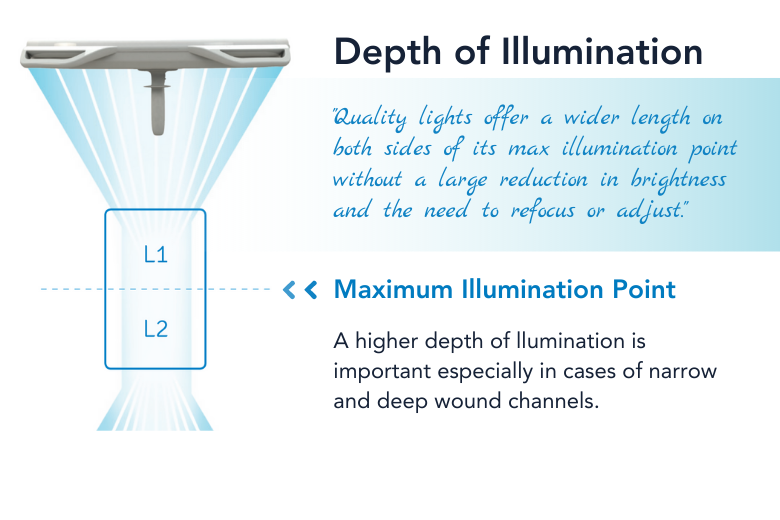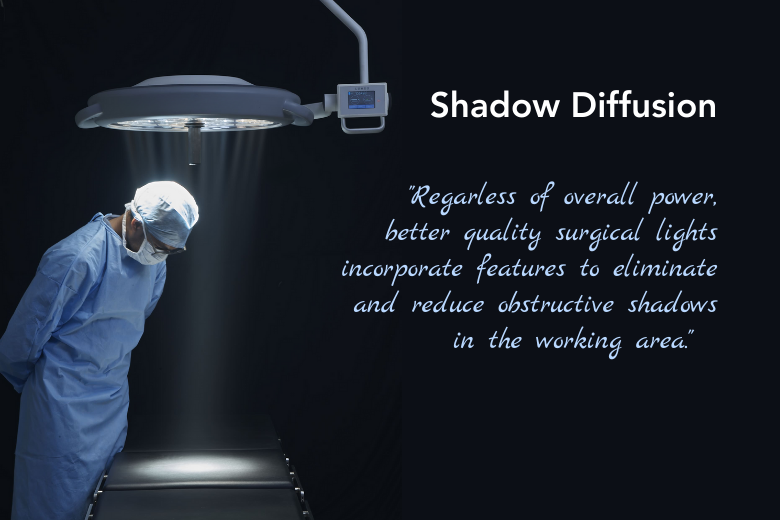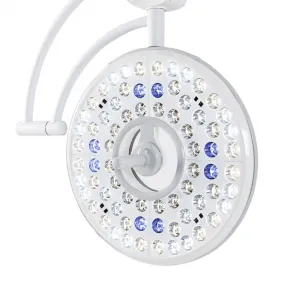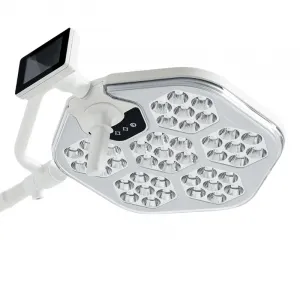There are three main factors that help deliver clear, high-intensity illumination to the site where a surgeon is actively working: Depth of Field, Uniformity of Focused Light, and Shadow Management & Diffusion. These factors ensure that the high-intensity output Lux that is advertised with most operating room lights actually reaches the working surgical field. The ability to do this well separates better quality products from entry-level and less well-made options.
Why Depth of Field Is Important
When discussing surgical, procedure, and operating room lighting, the term “depth of workable field” refers to the vertical distance over which the lighting system provides a consistent and adequate level of illumination. In other words, it represents the range within which the surgical or medical team can work comfortably and effectively without experiencing significant changes in lighting intensity or shadows.

The importance of a sufficient depth of workable field in operating room lights lies in its impact on the precision and accuracy of medical procedures. Here’s why it matters:
- Visibility and Clarity: Medical procedures often require a high level of precision, and adequate illumination is crucial for the surgical team to clearly see the surgical site, tissues, and instruments. A sufficient depth of workable field ensures that the entire surgical area remains well-lit, minimizing the risk of shadows and dark spots that could hinder visibility and compromise the surgeon’s ability to perform the procedure accurately.
- Reduced Eye Strain: Prolonged surgical procedures can be physically and mentally demanding for the surgical team. Insufficient lighting can strain the eyes of surgeons, nurses, and other medical staff, leading to fatigue and potential errors. A high depth of workable field helps distribute the light evenly across the surgical area, reducing eye strain and contributing to a more comfortable and focused working environment.
- Consistency and Reliability: Inconsistent lighting throughout the operating field can create distractions and make it challenging for medical professionals to maintain their concentration. Adequate depth of field ensures that the lighting remains consistent across the entire surgical site, allowing the team to work with confidence and precision.
The practical difference between a lighting system with a high depth of workable field and one with a lower depth of field can be quite significant:
- High Depth of Field: A lighting system with a high depth of workable field provides uniform and consistent illumination across a larger vertical range. This means that surgical teams can work comfortably and effectively within a broader area, reducing the likelihood of shadows and dark spots. Surgeons can move instruments and adjust their position without concerns about losing visibility, which enhances overall procedural accuracy and patient safety.
- Low Depth of Field: A lighting system with a lower depth of workable field might result in uneven lighting and pronounced shadows within a narrower vertical range. This can create challenges for the surgical team, as they may need to constantly adjust their position or instruments to maintain proper illumination. This could lead to increased eye strain, decreased precision, and potentially longer procedure times.
The depth of workable field in operating room lights is a critical factor that directly impacts the quality and safety of surgical procedures. A lighting system with a high depth of field ensures consistent and adequate illumination, leading to better visibility, reduced eye strain, and enhanced overall performance during medical interventions.
How Much Depth of Field to Expect
The measurement of a normal or appropriate depth of workable field for operating room lights can vary based on factors such as the specific type of surgery being performed, the size of the surgical area, and the preferences of the surgical team. However, as a general guideline, a common recommendation is to have a depth of workable field that extends from approximately 2 to 3 feet (about 60 to 100 centimeters) below the light fixture.
This range ensures that the surgical team has a sufficient vertical space within which they can work comfortably and effectively without experiencing significant changes in lighting intensity or shadows. It provides ample room for surgical instruments and the movement of medical personnel while maintaining consistent and uniform illumination.
It’s important to note that advancements in lighting technology and design may impact these recommendations, and specific guidelines might be provided by regulatory bodies or professional organizations in the healthcare field. Medical facilities and equipment manufacturers often consider ergonomic factors and best practices to determine the appropriate depth of workable field for their operating room lights.
Ultimately, the goal is to provide optimal lighting conditions that enhance visibility, reduce eye strain, and support the precision and accuracy required in surgical procedures. If you’re looking for specific measurements or recommendations for a particular type of surgery or lighting system, it’s advisable to consult with experts in the field, such as healthcare facility planners, lighting designers, or medical equipment suppliers.
Uniform & High Intensity Brightness At Different Focal Points
Entry level surgical lights often advertise a high end maximum Lux rating. Unfortunately they are not able to deliver that bright light to the surgical procedure area because of focal diffusion and poor shadow compensation. Better operating room lights achieve a uniform and high-intensity light field through a combination of advanced design, technology, and engineering. Lights that do a poor job with this can lose over 50% of their intensity as the field widens.

These lights are specifically designed to address the challenges of maintaining consistent illumination even when the light field is enlarged or focused. Here are some key factors that contribute to this capability:
- Optical Design: High-quality operating room lights employ sophisticated optical systems that are designed to distribute light evenly across the surgical area. These systems often incorporate reflectors, lenses, and diffusers to shape and direct the light. The design takes into account factors like beam angle, light intensity, and light diffusion to ensure uniform coverage.
- Multi-LED Arrays: Modern operating room lights may use arrays of multiple LED (light-emitting diode) modules. Each LED can be individually controlled, allowing for dynamic adjustments to the light field’s size, shape, and intensity. This precise control enables the lights to maintain uniform illumination even when the light field is changed.
- Light Diffusion and Reflection: Operating room lights may incorporate diffusers and reflective surfaces that scatter and redirect the light. This helps reduce harsh shadows and ensures that light is distributed evenly across the entire surgical field, even when the light is focused or expanded.
- Heat Management: Maintaining consistent light intensity also involves managing the heat generated by the lighting system. High-quality lights incorporate heat dissipation mechanisms to prevent overheating, which can affect both the performance of the LEDs and the comfort of the surgical team.
- Quality Materials: The use of high-quality materials, including advanced optical-grade lenses and coatings, contributes to the uniform distribution of light. These materials help minimize glare, hotspots, and light artifacts that can disrupt the surgical environment.
- Feedback Mechanisms: Some advanced operating room lights feature feedback mechanisms that monitor and adjust light output based on factors like distance to the surgical area, ambient light conditions, and the presence of obstacles. This continuous monitoring helps ensure consistent illumination regardless of changes in the environment.
- Smart Control Systems: Advanced operating room lights are equipped with intelligent control systems that allow for real-time adjustments. Surgeons or medical staff can modify the focus, intensity, and size of the light field using touch controls or remote devices. These systems can compensate for changes in the surgical area, patient position, or equipment setup.
Overall, the combination of precise optical design, LED technology, intelligent control systems, and thoughtful engineering allows modern operating room lights to maintain a uniform and high-intensity light field even when adjustments are made to the focus or size of the light. This capability plays a crucial role in supporting optimal visibility, reducing eye strain, and enhancing the overall efficiency and safety of surgical procedures.
Advanced Shadow Diffusion
Shadow diffusion ( also known as the dilution effect ) in operating room lights involves techniques and design elements that help manage obstructions by minimizing or softening the appearance of shadows within the surgical field. Given the position of the surgeon and staff in relation to the patient during procedures it is inevitable that parts of the practitioners head, arms, body, and hands will occasionally be between the light and the surgical site. Shadows can be a big problem during surgical procedures as they can obscure visibility, hinder accurate instrument manipulation, and potentially lead to errors.

Better quality operating room lights do an excellent job of reducing shadows and ensure a clear and bright work area. Here’s how it works:
- Diffusers and Scattering: Operating room lights with shadow diffusion capabilities often use diffusers or scattering elements in their optical design. These components are placed in front of the light source to break up and scatter the light rays. This diffusion helps to create a more even distribution of light across the surgical area, reducing the intensity of shadows and creating a smoother transition between illuminated and shadowed regions.
- Optimized Beam Angles: The placement and angle of the light sources in high-quality operating room lights are carefully designed to minimize the casting of shadows caused by surgical instruments, medical staff, or other obstructions. By optimizing the beam angles across a wide surface area, the lights can better illuminate critical areas without causing obstructive shadows.
- Extra Wide or Multiple Light Head: Operating room lights utilize multiple light sources positioned at different angles. By directing light from multiple angles, the overlapping beams help to fill in areas that might otherwise be in shadow. This multi-directional approach contributes to more comprehensive and uniform lighting coverage. For intense surgical environments it may be normal to have two or three light heads pointing from different angles to nearly completely eliminate any shadowing.
- Controllable Light Patterns: Certain operating room lights allow surgeons to adjust the light pattern or distribution based on the specific needs of the procedure. This can involve changing the orientation of individual light modules or adjusting the focus and intensity of different sections of the light field. By customizing the light pattern, surgeons can minimize shadows where they are most problematic. Be sure to consider systems that do not lose significant brightness while focusing out to a wider field.
- Anti-Glare Coatings: High-quality operating room lights may incorporate anti-glare coatings on their surfaces. These coatings help reduce specular reflections that can create unwanted shadows or cause glare on reflective surfaces. By minimizing glare, the lights contribute to a clearer and more shadow-free surgical environment.
- Uniform Illumination: Better quality lights are designed to provide uniform illumination across the entire surgical field. This means that the intensity of light remains consistent throughout, minimizing abrupt changes in lighting that could result in harsh shadows. Uniform illumination helps ensure that no part of the surgical area is disproportionately illuminated or shadowed.
- Ergonomic Design: The physical design of the light fixture, including its shape and dimensions, can also contribute to shadow reduction. Ergonomically designed lights take into consideration the positions of the surgeon, medical staff, and equipment to ensure that shadows are minimized, and critical areas are well-illuminated.
In summary, shadow diffusion or the dilution effect in operating room lights is achieved through a combination of optical design, light source arrangement, control features, and surface treatments. Better quality operating room lights employ these techniques to create a more uniform and shadow-free surgical environment, enhancing visibility, precision, and overall procedural safety.



